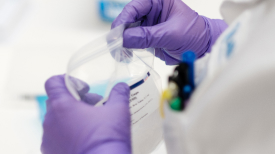- Cancer Care Team
Cancer Care Team
To deliver optimal patient outcomesProducts and Services
Cancer Type
Supplies & Tools
Scientific Focus
- Biopharma Partners
- Patients
- Education & Events
- Login
- Contact Us
Test Details
 Cancer Type
Cancer Type
Hematologic malignancies
 Technology Used
Technology Used
NGS
 Turnaround Time
Turnaround Time
10 - 14 days
Use
This test is used to aid diagnosis, prognostic risk assessment and therapeutic selection in various myeloid and lymphoid malignancies.
Special Instructions
Please provide a clinical indication or related ICD-10 code on the requisition. Test will be delayed if the clinical indication is not received. Please direct any questions regarding this test to customer service at 800-345-4363.
Test Includes
This test includes the following genes: ABL1, ANKRD26, ARID1A, ASXL1, ATM, ATRX, B2M, BCL2, BCL6, BCOR, BCORL1, BIRC3, BRAF, BRCC3, BTK, CALR, CARD11, CBL, CBLB, CBLC, CCND1, CCND3, CD274, CD79A, CD79B, CDK4, CDKN1B, CDKN2A, CDKN2B, CEBPA, CIITA, CREBBP, CRLF2, CSF1R, CSF3R, CSNK1A1, CTCF, CUX1, CXCR4, DDX41, DKC1, DNMT3A, EBF1, ELANE, EP300, ERG, ETNK1, ETV6, EZH2, FAS, FBXW7, FGFR1, FGFR3, FLT3, FOXO1, GATA1, GATA2, GNA13, GNAS, GNB1, HRAS, IDH1, IDH2, IKZF1, IKZF3, IL7R, IRF4, JAK1, JAK2, JAK3, KDM6A, KIT, KMT2A, KRAS, MALT1, MAP2K1, MAPK1, MED12, MEF2B, MPL, MYC, MYD88, NF1, NFE2, NOTCH1, NOTCH2, NPM1, NRAS, NSD2, NT5C2, P2RY8, PAX5, PDCD1, PDGFRA, PHF6, PIGA, PIK3CA, PIK3CD, PIK3CG, PIK3R1, PIM1, PLCG2, PML, POT1, PPM1D, PRDM1, PRPF8, PTEN, PTPN11, RAD21, RB1, RHOA, RIT1, RUNX1, SAMD9, SAMD9L, SBDS, SETBP1, SETD2, SF3B1, SH2B3, SMC1A, SMC3, SOCS1, SRSF2, STAG2, STAT3, STAT5B, STAT6, TCF3, TERC, TERT, TET2, TNFAIP3, TNFRSF14, TP53, U2AF1, WT1, UBA1, XPO1 and ZRSR2.
Limitations
The sensitivity of this assay is 3% variant allele fraction (VAF) for single nucleotide variants (SNV), 5% for insertions/deletions (indels) less than 25 base pairs (bp) and 15% indels greater than or equal to 25 bp. CNV sensitivity is greater than or equal to two contiguous exons (subset) to whole gene is copy number less than or equal to 0.85 for deletions and greater than or equal to 1.15 for gains.
Multiple clinically actionable hotspots have increased VAF sensitivity and include FLT3-ITDs down to 1% VAF, as well as Indel hotspots in CALR (chr19:13054563-13054625) and CEBPA (chr19:33,792,224-33,793,340) with VAF sensitivity greater than or equal to 5% for indels regardless of length. Insertions and deletions of any length are detected when at least one breakpoint is contained within a sequence read. Insertions up to 162 bp and deletions up to 95 bp have been detected in clinical specimens. Mutations outside the targeted regions and gene rearrangements will not be detected.
Variants are categorized into tiers based on their clinical impact, following a joint consensus recommendation from the AMP, ASCO and CAP. Clinical and experimental evidence grouped into four levels (A-D) based on significance in clinical decision making (therapeutic, diagnosis, prognosis) is assigned to variants to determine their clinical significance: Tier 1, Variants with Strong Clinical Significance (level A and B evidence); Tier 2, Variants with Potential Clinical Significance (level C or D evidence); Tier 3, Variants of Unknown Clinical Significance and Tier 4, Benign or Likely Benign. Results should be interpreted in conjunction with clinical and other laboratory findings for the most accurate interpretation.
This test was developed and its performance characteristics determined by Labcorp. It has not been cleared or approved by the Food and Drug Administration.
Methodology
The Labcorp Pan-Heme NGS assay utilizes capture-based next-generation sequencing of whole genomic DNA libraries to identify gene alterations that have diagnostic, prognostic and therapeutic significance in hematologic malignancies. Somatic mutations in the genes analyzed include single nucleotide variants (SNVs), insertions and deletions (indels) in 141 genes and whole gene copy number variants (CNVs) in a subset of 16 genes and sub-gene (exon level) genes in a subset of five genes.
References
Agency for Healthcare Research and Quality. Quality, Regulation and Clinical Utility of Laboratory-developed Tests. Centers for Medicare & Medicaid Services (CMS) website: http://www.cms.gov/determinationprocess/downloads/id72TA.pdf. Updated October 6, 2010. Accessed May 2025.
Au CH, Leung AYH, Kwong A, Chan TL, Ma ESK. INDELseek: detection of complex insertions and deletions from next-generation sequencing data. BMC Genomics. 2017 Jan 5;18(1):16. PubMed 28056804
Auton A, Brooks LD, Durbin RM, et al. A global reference for human genetic variation. Nature. 2015 Oct 1; 526(7571):68-74. PubMed 26432245
Canchola JA, Hemyari P. Limit of Detection (LoD) Estimation Using Parametric Curve Fitting to (Hit) Rate Data: The LoD_Est SASr Macro. SAS Macros: Analytical Sensitivity Estimation 10; 2016. Accessed May 2025 at https://support.sas.com/resources/papers/proceedings16/1720-2016.pdf.
Cleveland WS. LOWESS: A program for smoothing scatterplots by robust locally weighted regression. The American Statistician. 1981;35.1:54.
Clinical and Laboratory Standards Institute. Collection, Transport, Preparation, and Storage of Specimens for Molecular Methods; Approved Guideline. CLSI document MM13- A, Vol 25 No 31. 2005; Wayne, PA, pages 12-16.
Clinical and Laboratory Standards Institute. Molecular Methods For Clinical Genetics And Oncology Testing. CLSI document MM1-A3. 2012; Wayne, PA.
College of American Pathologists (CAP) Next Generation Sequencing Guidelines, Molecular Pathology Checklist. July 31, 2012.
Cushwa WT, Medrano, JF. Effects of blood storage time and temperature on DNA yield and quality. Biotechniques. 1993 Feb;14(2):204-207. PubMed 8431281
Dong M, Cioffi G, Wang Jacqueline, et al. Sex differences in cancer incidence and survival: a pan-cancer analysis. Cancer Epidemiol Biomarkers Prev. 2020 Jul:29(7)1389-1397. PubMed 32349967
Feldkamp JD, Vetter VM, Arends CM, et al. Clonal hematopoiesis of indeterminate potential-related epigenetic age acceleration correlates with clonal hematopoiesis of indeterminate potential clone size in patients with high morbidity. Haematologica. 2022 Jul 1:107(7):1703-1708. PubMed 35236052
Genome Reference Consortium. Human Genome Assembly GRCh37.p13. Accessed May 2025 at https://www.ncbi.nlm.nih.gov/grc/human/data?asm=GRCh37.p13.
Kapa Biosystems. KAPA HyperPlus Kit Technical Data Sheet KR1145-v4.17.
Kim JJ, Lee KS, Lee TG, Lee S, Shin S, Lee ST. A comparative study of next-generation sequencing and fragment analysis for the detection and allelic ratio determination of FLT3 internal tandem duplication. Diagn Pathol. 2022 Jan 26;17(1):14. PubMed 35081962
Krusche P, Trigg L, Boutros PC, et al. Best practices for benchmarking germline small-variant calls in human genomes. Nature Biotechnol. 2019 May;37(5):555-560. PubMed 30858580
Labcorp. CMBP New Test Validation. SOP (LC-TG-GN-POL-2).
Labcorp Clinical Trials Division. Global Policy on Validation of New Testing Methods, Policy Number: CT-GLOB-GLAB-SOP-4.
Larrea A, Yuan G, Wagner K, et al. A simple segue from Sanger to high-throughput SMRT Sequencing with a M13 barcoding system [poster]. 2018. Accessed May 2025 at www.pacb.com/wp-content/uploads/Aro-ASHG-2018-Targeted-Sequencing-M13-10-6-2018-FINAL.pdf.
Li H, Durbin R. Fast and accurate short read alignment with Burrows-Wheeler transform. Bioinformatics. 2009 Jul 15;25(14):1754-1760. PubMed 19451168
Mahalanobis PC. On the generalized distance in statistics. Sankhya: The Indian Journal of Statistics, Series A (2008-). 2018;80:S1-S7.
Mose LE, Wilkerson MD, Hayes DN, Perou CM, Parker JS. ABRA: improved coding indel detection via assembly-based realignment. Bioinformatics. 2014 Oct;30(19):2813-2815. PubMed 24907369
Mosteller F, Tukey JW. Data analysis and regression. A second course in statistics. Addison-Wesley series in behavioral science: quantitative methods. 1977.
NextSeq 550 System Guide. Document No. 15069765 v06. June 2019.
NextSeq System Denature and Dilute Libraries Guide. Document No. 15048776 v13. November 2019.
QuantiFluor dsDNA System Technical Manual TM346. Revised December 2018.
Qubit® dsDNA HS Assay Kit Users Guide. Catalogue No. Q32851. September 28, 2010.
Rancoita PMV, Hutter M, Bertoni F, Kwee I. Bayesian DNA copy number analysis. BMC Bioinformatics. 2009 Jan 8;10:10. PubMed 19133123
SAM/BAM Format Specification Working Group. Sequence Alignment/Map Format Specification. Updated November 6, 2024. Accessed May 2025 at https://samtools.github.io/hts-specs/SAMv1.pdf.
Sherry ST, Ward MH, Kholodov M, et al. dbSNP: the NCBI database of genetic variation. Nucleic Acids Res. 2001 Jan 1;29(1):308-311. PubMed 11125122
Tate JG, Bamford S, Jubb HC, et al. COSMIC: the catalogue of somatic mutations in cancer. Nucleic Acids Res. 2019 Jan 8;47(D1):D941-D947. PubMed 30371878
Twist Fast Hybridization Target Enrichment Protocol. Rev2.0. May 14, 2021.
Universal Molecular Method Validation SOP. General Guidelines for all Labcorp testing facilities. LC-CORP-ST-SOP-70.
US Food and Drug Administration. FDA Guidance for Industry: Bioanalytical Method Validation. May 2001.
Weng S, Stoner SA, Zhang DE. Sex chromosome loss and the pseudoautosomal region genes in hematological malignancies. Oncotarget. 2016 Nov 1;7(44):72356-72372. Pubmed 27655702
xGen Hybridization of DNA libraries for NGS target enrichment. V4.0; 2019.
Specimen Requirements
Information on collection, storage, and volume
Specimen
Whole blood, bone marrow, cell pellets from whole blood or cell suspension
Volume
3-5 mL (blood), 1-2 mL (bone marrow)
Minimum Volume
3 mL (blood), 1 mL (bone marrow)
Container
Lavender-top (EDTA) tube, green-top (sodium heparin) tube, tan-top (K2-EDTA) tube or pink-top (K2-EDTA) tube; cells left over from flow cytometry analysis either fresh cell suspension or fresh/frozen cell pellet spun down from suspension (cell suspension should be shipped on ice)
Storage Instructions
Once received, refrigerate at 2°C to 8°C.
Causes for Rejection
Specimen does not meet criteria for sample type, container, minimum volume, collection and storage; frozen whole blood or marrow; leaking tube; clotted blood or marrow; grossly hemolyzed specimen or otherwise visibly degraded; contaminated specimen; contains suspicious foreign material
Related Tests
Find more tests related to this one.





